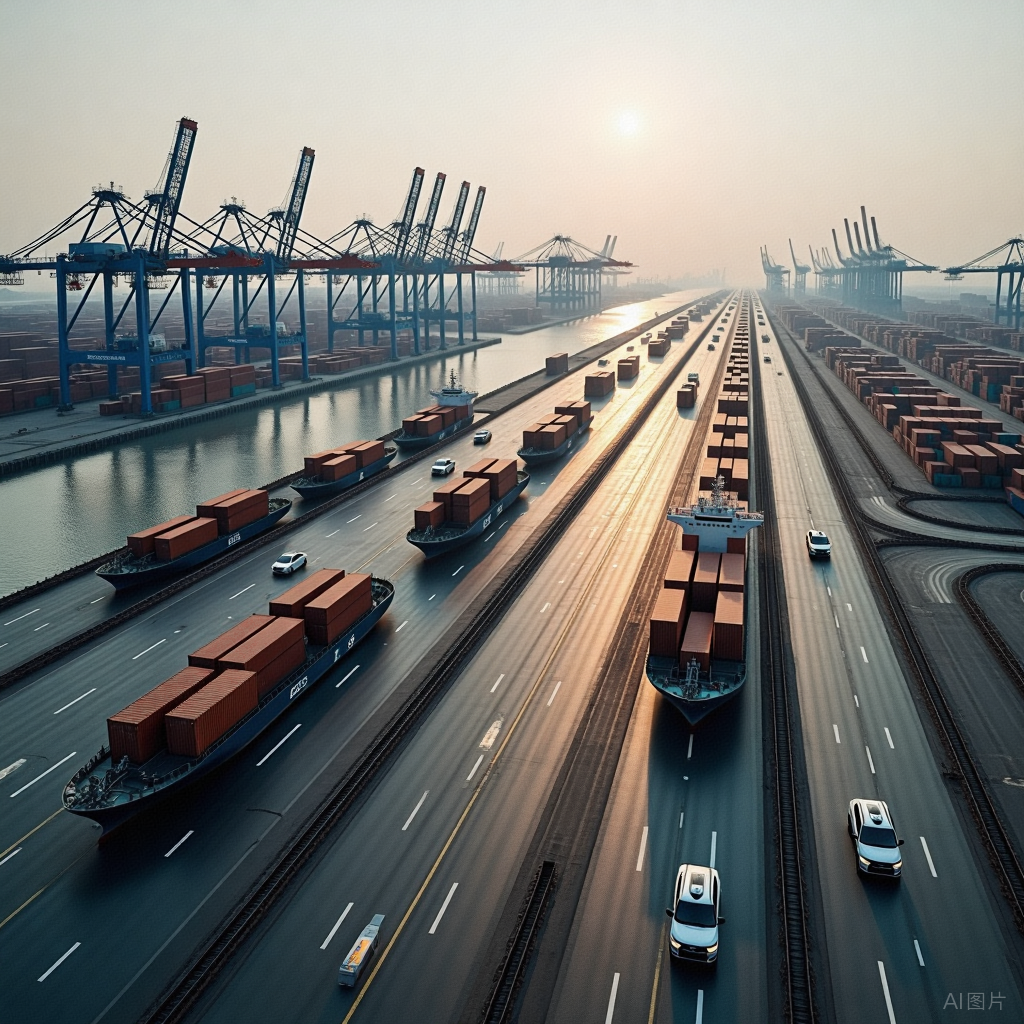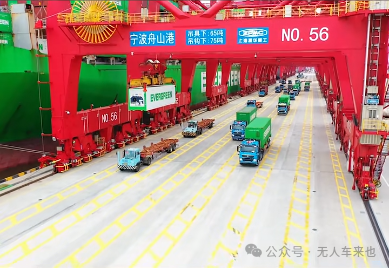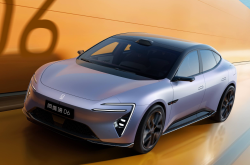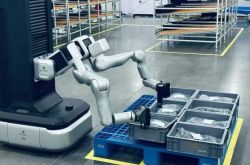Revolutionizing Ports: How China's Autonomous Trucks Are Quietly Conquering Global Ports
![]() 05/09 2025
05/09 2025
![]() 852
852
Introduction
At the wee hours of 2 a.m. in Nansha Port, Guangzhou, a fleet of 158 driverless IGVs (Intelligent Guided Vehicles) glides smoothly through the darkness, marking the establishment of China's largest single-terminal IGV system.
These autonomous vehicles thrive without caffeine, ignore overtime, and never falter due to late-night distractions—truly embodying the port industry's dream employees: high efficiency, low cost, and 24/7 reliability.
This scene is now a common sight in major Chinese ports:
Ningbo-Zhoushan Port: 102 driverless trucks operate seamlessly across six routes. The terminal manager quips, "Drivers used to gripe about night shifts, but now, machines don't even need social security!"
Tianjin Port: A wave of 165 autonomous vehicles, managed by a single dispatcher, slashes labor costs in half.
Yangluo Port: Dongfeng's driverless trucks, akin to giant sweeping robots, complete a 1-kilometer journey in 10 minutes, saving RMB 380,000 annually per vehicle in operating costs.
Driverless Vehicles Are Coming (WeChat public account: Driverless Vehicles Are Coming) believes:
This silent "terminal revolution" transforms Chinese ports into the world's largest autonomous driving testbed, with a business logic far more pragmatic and lucrative than that of autonomous passenger vehicles.
(For further reference, please click:
"Chinese Autonomous Driving Enterprises 'Going Global': The 'Chinese Power' of Global Smart Ports")

I. Why Have Ports Become the 'Golden Track' for Autonomous Driving?
1. Autonomous Trucks: A Timely Solution to Port Transportation Challenges
Ports, vital links in global trade, witness surging cargo volumes, with some Chinese ports surpassing the hundred-million-ton mark annually.
Under this immense logistical pressure, traditional port transportation methods falter. The younger generation shuns port driving jobs due to arduous work and poor conditions, leading to recruitment woes and escalating labor costs.
Manual driving, plagued by fatigue and emotions, results in efficiency fluctuations and frequent safety incidents, causing substantial losses to port operations. Thus, the intelligent transformation of ports is imperative.
Autonomous trucks emerge as a timely solution, offering new avenues to address port transportation issues.
2. Closed Scenarios: The Ideal Playground for Autonomous Driving
Ports, free from the chaos of electric bikes and aggressive drivers on open roads, are a haven for autonomous vehicles:
Fixed Routes: Containers traverse from point A to point B, following routes as predictable as a worker's daily schedule.
Low-Speed Operation: At 20 km/h, even collisions are mere 'kisses' between containers.
Policy Support: Explicitly endorsed by the Ministry of Transport, terminals welcome this innovation with enthusiasm.
3. Economic Calculus: Machines Outperform Humans in Cost-Effectiveness
Labor Costs: Traditional terminal drivers earn over RMB 150,000 annually, requiring three shifts. Machine Costs: Each driverless truck costs RMB 600,000-800,000 but operates continuously for five years without breaks, averaging to less than RMB 200,000 per year. Hidden Benefits: Machines drive without fatigue, eliminating port accidents—much to insurance companies' delight. For instance, after a three-month trial at Yangluo Port, Dongfeng's driverless trucks reduced the cost of transporting a single container by 30%, prompting the terminal to place additional orders overnight.
II. Technological Breakthrough: Overcoming Western Giants with 'Local Wisdom'
Autonomous trucks navigate complex port environments seamlessly, powered by advanced technologies that grant them 'smart brains' and 'sharp senses,' enabling intelligent decision-making and task execution.
1. Millimeter-Level Precision with a Cost-Effective Solution
To conquer dynamic port environments, Chinese enterprises devised a budget-friendly 'lidar + fisheye camera' combination.
Tianjin Port and Shanghai Zhenhua Heavy Industries co-developed the world's first integrated management system for container operations, pioneering the control and management of an entire unmanned automated system through a single platform.
Zhenhua's driverless trucks use locally produced lidars priced at RMB 80,000, a fraction of the RMB 400,000 imported alternatives. Compensating for precision loss through AI algorithms, they achieve a container grasping error of <3cm, slashing costs by 70%.
2. 'Cheating Device' for Seamless Vehicle-Road Coordination
A 5G-led technological revolution flourished in Yantian Port, Shenzhen. In late 2021, the port's eastern operation area launched an automated terminal project. Taking electric driverless trucks as a pivot, Yantian Port aimed to build a highly automated container terminal. Early and cost-effective vehicle-road coordination construction underpinned this initiative.

3. The Magic of Dynamic High-Precision Maps
Feibu Technology's dynamic map system, tailored for Zhoushan Port's complex environment, updates container yard changes within 15 seconds.
After Typhoon Mangkhut in 2024, the system reconstructed the entire port map in just two hours, 120 times faster than manual surveying and mapping.
III. Business Secrets: From Technological Validation to Large-Scale Profitability
From a commercial standpoint, autonomous trucks excel in cost reduction and efficiency enhancement, offering new hope for port operations!
1. From Tech Sales to Capacity Sales: The 'Port Didi' Model
Feibu Technology: Signed a five-year transport capacity service contract with Ningbo-Zhoushan Port, charging per transported container. Rates are 30% lower than manual labor but yield a higher net profit margin.
Sinian Intelligent Driving: Launched 'unmanned transport flatbed leasing' in Tangshan Port, with the terminal paying by the hour. Revenues surpassed RMB 200 million in 2023, with a gross margin exceeding 50%.
Capital Frenzy: Sinian Intelligent Driving raised hundreds of millions of yuan in four years, attracting investments from ByteDance and Lehe Capital. Feibu Technology was designated a national-level 'little giant,' with its valuation soaring to RMB 8 billion.
2. The Ultimate Cost-Cutting Weapon: Minimizing Labor Costs
Traditional Ports: 100 container trucks require 300 drivers + management personnel, totaling an annual salary of RMB 150 million. Driverless Fleet: The same scale needs only 20 operations and maintenance personnel, reducing costs to RMB 10 million and saving RMB 140 million annually.
Xijing Technology's Q-Truck saved over RMB 220 million in labor costs after three years in Laem Chabang Port, Thailand.
3. Integrated 'Hardware + Software + Service' Solutions
Autonomous driving enterprises offer a comprehensive 'vehicles + dispatching system + operations and maintenance services' package, charging based on transport volume or service duration.
4. Continuous Optimization Driven by Data
Algorithms improve iteratively through real port operation data, enhancing system adaptability. Mainline Technology's driverless trucks in Beijing Yizhuang Port collect over 10TB of data daily, supporting quarterly updates to their decision-making model.
IV. Chinese Enterprises: Global Leaders in Port Autonomous Driving
In port autonomous driving, Chinese enterprises showcase robust innovation and market competitiveness, with numerous firms dedicating themselves to driving industry development.
Xijing Technology stands out.
Its self-developed Q-Truck autonomous trucks have achieved commercial success in multiple global ports.
In Thailand's Laem Chabang Port, the Q-Truck fleet operates alongside manually driven vehicles, efficiently handling container transportation and significantly boosting port efficiency, becoming a global benchmark for port intelligent transformation.
In Felixstowe Port, UK, Xijing Technology signed a contract for 100 Q-Trucks, creating Europe's largest new energy unmanned fleet, prompting British media to exclaim, "Chinese trucks are taking over ports!"
In other European and American ports, Xijing Technology collaborates deeply, tailoring intelligent solutions to facilitate a smooth transition from manned to unmanned driving.
Mainline Technology also shines.
Its intelligent driving system is widely used in ports, logistics parks, and other scenarios.
In Tianjin Port, Mainline Technology's autonomous container trucks seamlessly integrate with port automation equipment, achieving full-process automation and elevating port automation levels.
Furthermore, firms like Sinian Intelligent Driving and Youdao Intelligent Way are making waves in port autonomous driving, continuously launching innovative products and solutions, propelling China's port intelligentization to the forefront of the world.
Youdao Intelligent Way deployed 40 driverless trucks in Peru's Callao Port, marking China's largest single autonomous driving export order.
Zhenhua Heavy Industries supplied 46 AGVs to Singapore's Tuas Port, with the fully automated terminal's construction cost being 60% lower than European solutions.
In conclusion, Driverless Vehicles Are Coming (WeChat public account: Driverless Vehicles Are Coming) unveils the 'Chinese secrets' of unmanned terminals:
While autonomous passenger vehicles grapple with 'L3 or L4,' port players have quietly dominated the global market with the mantra of 'usable, easy to use, and cost-saving.'
A thought-provoking question: When all ports become unmanned, will containers feel lonely?
What do you think?
#DriverlessVehiclesAreComing #AutonomousDriving #AutonomousTrucksInPorts






